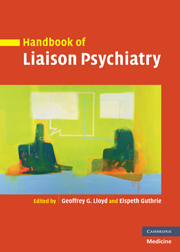Book contents
- Frontmatter
- Contents
- List of contributors
- Preface
- Part I Basic skills
- Part II Common psychiatric problems across the general hospital
- Part III Working with specific units
- 14 Neurological disorders
- 15 Cardiorespiratory disorders
- 16 Gastrointestinal disorders
- 17 Liver disorders
- 18 Endocrine disorders
- 19 Diabetes
- 20 HIV and AIDS
- 21 Renal disease
- 22 Musculo-skeletal disorders
- 23 Oncology
- 24 Head and neck cancer
- 25 Palliative care
- 26 Cosmetic procedures
- 27 Perinatal and gynaecological disorders
- 28 The intensive care unit
- 29 The burns unit
- 30 Psychocutaneous disorders
- 31 Genitourinary disorders
- 32 The emergency department
- Part IV Treatment
- Part V Different treatment settings
- Index
- References
15 - Cardiorespiratory disorders
from Part III - Working with specific units
Published online by Cambridge University Press: 10 December 2009
- Frontmatter
- Contents
- List of contributors
- Preface
- Part I Basic skills
- Part II Common psychiatric problems across the general hospital
- Part III Working with specific units
- 14 Neurological disorders
- 15 Cardiorespiratory disorders
- 16 Gastrointestinal disorders
- 17 Liver disorders
- 18 Endocrine disorders
- 19 Diabetes
- 20 HIV and AIDS
- 21 Renal disease
- 22 Musculo-skeletal disorders
- 23 Oncology
- 24 Head and neck cancer
- 25 Palliative care
- 26 Cosmetic procedures
- 27 Perinatal and gynaecological disorders
- 28 The intensive care unit
- 29 The burns unit
- 30 Psychocutaneous disorders
- 31 Genitourinary disorders
- 32 The emergency department
- Part IV Treatment
- Part V Different treatment settings
- Index
- References
Summary
Introduction
This chapter attempts to describe how psychosocial factors influence both cardiovascular and respiratory diseases. This will include an exploration of not only the ways in which psychosocial factors contribute to ‘disease risk’, but also the psychological consequences of disorders such as coronary heart disease (CHD) and chronic obstructive pulmonary disease (COPD). Psychosocial aspects of the transplantation of major organs will also be described. Only brief mention will be made of other topics such as non-cardiac chest pain and hyperventilation, which will be dealt with elsewhere (Chapter 7).
Cardiovascular disorders
Coronary heart disease
Around one-quarter of all deaths among men and one-fifth of all deaths of women in Britain are due to CHD. Among women the proportion is relatively stable throughout the adult years, whilst in men it peaks among 55–64-year-olds, for whom CHD accounts for a third of all deaths. The National Health Service in England deals with around 200 000 inpatient episodes due to CHD for men and 100 000 for women each year, representing around 5% of all hospital inpatient episodes for men and 3% for women. In addition, there are about 30 million work days lost due to certified incapacity for CHD among men and over 4 million among women each year in Britain (Ness & Davey-Smith 2003).
Coronary heart disease rates in Britain increased from the beginning of the century until the 1980s for men, but since the late 1970s CHD mortality has declined steadily in both men and women.
Keywords
- Type
- Chapter
- Information
- Handbook of Liaison Psychiatry , pp. 365 - 389Publisher: Cambridge University PressPrint publication year: 2007
References
- 3
- Cited by



